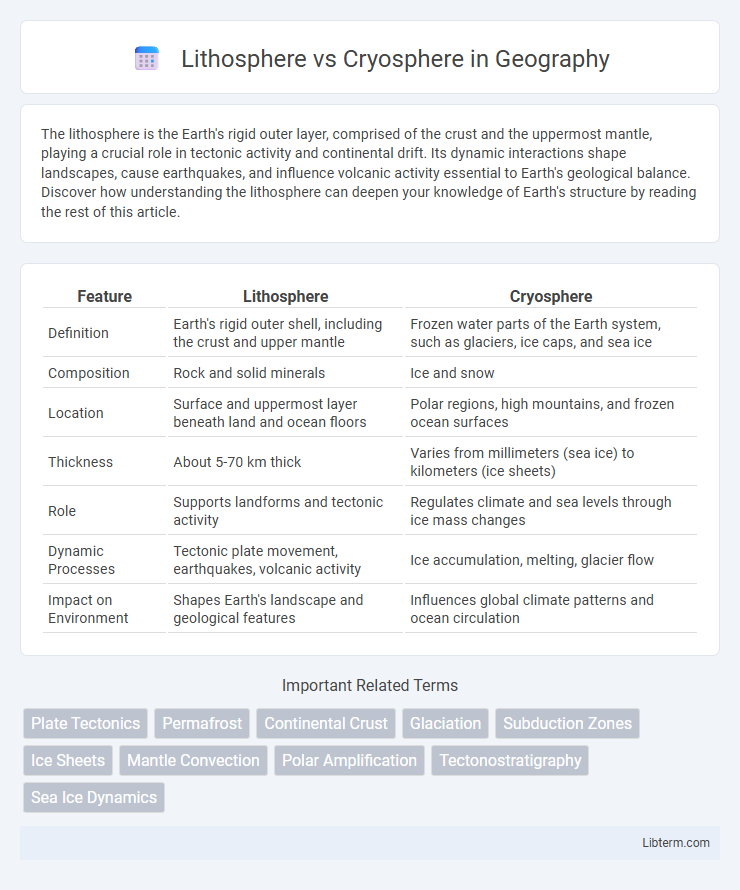The lithosphere is the Earth's rigid outer layer, comprised of the crust and the uppermost mantle, playing a crucial role in tectonic activity and continental drift. Its dynamic interactions shape landscapes, cause earthquakes, and influence volcanic activity essential to Earth's geological balance. Discover how understanding the lithosphere can deepen your knowledge of Earth's structure by reading the rest of this article.
Table of Comparison
| Feature | Lithosphere | Cryosphere |
|---|---|---|
| Definition | Earth's rigid outer shell, including the crust and upper mantle | Frozen water parts of the Earth system, such as glaciers, ice caps, and sea ice |
| Composition | Rock and solid minerals | Ice and snow |
| Location | Surface and uppermost layer beneath land and ocean floors | Polar regions, high mountains, and frozen ocean surfaces |
| Thickness | About 5-70 km thick | Varies from millimeters (sea ice) to kilometers (ice sheets) |
| Role | Supports landforms and tectonic activity | Regulates climate and sea levels through ice mass changes |
| Dynamic Processes | Tectonic plate movement, earthquakes, volcanic activity | Ice accumulation, melting, glacier flow |
| Impact on Environment | Shapes Earth's landscape and geological features | Influences global climate patterns and ocean circulation |
Introduction to the Lithosphere and Cryosphere
The lithosphere consists of the Earth's rigid outer layer, including the crust and upper mantle, serving as the foundation for tectonic activity and landforms. The cryosphere encompasses all frozen water parts of the Earth system, such as glaciers, ice sheets, sea ice, and permafrost, playing a crucial role in global climate regulation and sea-level changes. Both spheres interact dynamically, influencing geological processes and Earth's climate systems.
Defining the Lithosphere: Structure and Composition
The lithosphere, Earth's rigid outer layer, consists of the crust and the uppermost mantle, extending roughly 100 kilometers deep. It is composed primarily of silicate minerals and is divided into tectonic plates that float atop the more ductile asthenosphere. This solid structure contrasts with the cryosphere, which includes frozen water regions like glaciers, ice caps, and sea ice.
Understanding the Cryosphere: Components and Distribution
The cryosphere comprises all frozen water parts on Earth, including glaciers, sea ice, permafrost, and snow cover, playing a critical role in climate regulation and sea-level control. Its distribution spans polar regions like Antarctica and the Arctic, as well as high-altitude mountainous zones such as the Himalayas and the Andes, where cryospheric components influence hydrological cycles. Understanding these frozen reservoirs provides insights into global temperature trends, ice sheet stability, and their effects on the lithosphere and biosphere.
Key Differences Between Lithosphere and Cryosphere
The lithosphere encompasses the rigid outer layer of the Earth, including the crust and upper mantle, responsible for tectonic activities and plate movements, whereas the cryosphere consists of Earth's frozen water components such as glaciers, ice caps, and permafrost. The lithosphere plays a crucial role in geological processes like earthquakes and mountain formation, while the cryosphere significantly impacts climate regulation and sea-level changes through ice melt and accumulation. Distinctly, the lithosphere is solid rock-based, whereas the cryosphere is primarily composed of water in its solid state, influencing different environmental and geological dynamics.
Interactions Between Lithosphere and Cryosphere
The lithosphere and cryosphere interact significantly through processes like glacial erosion and isostatic rebound, where the weight of ice sheets deforms the Earth's crust. Melting glaciers reduce pressure on the lithosphere, causing uplift and altering geological structures. These interactions influence sea level changes, sediment transport, and landscape evolution in polar and alpine regions.
Importance of the Lithosphere in Earth's Systems
The lithosphere, comprising the Earth's rigid outer layer of the crust and upper mantle, plays a crucial role in tectonic activity that shapes landscapes, influences seismic events, and regulates nutrient cycling essential for ecosystems. Its interaction with the atmosphere, hydrosphere, and biosphere drives natural processes such as volcanic eruptions and mountain formation, crucial for climate regulation and habitat creation. Unlike the cryosphere, which primarily impacts climate regulation through ice and snow cover, the lithosphere serves as the foundation of terrestrial life and the dynamic engine behind Earth's geological evolution.
Role of the Cryosphere in Climate Regulation
The cryosphere, comprising frozen water in glaciers, ice caps, and sea ice, reflects solar radiation through high albedo, thus playing a crucial role in Earth's energy balance and climate regulation. Melting ice reduces this reflectivity, leading to increased absorption of heat and accelerated global warming. The lithosphere interacts with the cryosphere by influencing glacial formation through tectonic activity and topography, indirectly affecting climate patterns over geological timescales.
Human Impacts on Lithosphere and Cryosphere
Human activities significantly impact the lithosphere through deforestation, mining, and urban expansion, leading to soil degradation, habitat loss, and increased erosion. The cryosphere is affected by anthropogenic climate change, causing accelerated glacier melting, permafrost thaw, and sea ice retreat, which disrupt ecosystems and contribute to global sea-level rise. These changes in both spheres intensify environmental challenges, including altered water cycles and increased natural disaster risks.
Current Research and Discoveries
Current research on the lithosphere focuses on tectonic plate movements, earthquake dynamics, and mantle composition, revealing new insights into continental drift and seismic activity patterns. Advances in cryosphere studies emphasize shrinking ice sheets, melting glaciers, and permafrost thaw, driven by satellite observations and climate models that highlight accelerating impacts on global sea levels. Interdisciplinary studies explore the interactions between lithospheric processes and cryospheric changes, enhancing understanding of Earth's evolving climate system.
Future Challenges and Conservation Efforts
Rising global temperatures intensify the melting of the cryosphere, threatening polar ice caps and glaciers, which accelerates sea-level rise and disrupts Earth's climate regulation. The lithosphere faces increased stress from human activities such as mining and deforestation, exacerbating soil erosion and habitat loss. Conservation efforts prioritize reducing greenhouse gas emissions, protecting vulnerable ecosystems, and implementing sustainable land-use practices to mitigate the impacts on both the lithosphere and cryosphere.
Lithosphere Infographic

 libterm.com
libterm.com